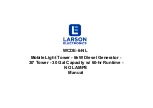
82001i-DF (EU)
82001i-DF (EU)
IMPORTANT SAFETy INSTRUcTIONS
IMPORTANT SAFETy INSTRUcTIONS
4
5
EN
WARNING
Running engines produce heat. Severe burns can occur on
contact. Combustible material can catch fire on contact.
DO NOT touch hot surfaces.
Avoid contact with hot exhaust gases.
Allow equipment to cool before touching.
Maintain at least 3 ft. (91.4 cm) of clearance on all sides to
ensure adequate cooling.
Maintain at least 5 ft. (1.5 m) of clearance from combustible
materials.
WARNING
Rapid retraction of the starter cord will pull hand and arm
towards the engine faster than you can let go. Unintentional
startup can result in entanglement, traumatic amputation or
laceration. Broken bones, fractures, bruises or sprains could
result.
When starting engine, pull the starter cord slowly until
resistance is felt and then pull rapidly to avoid kickback.
DO NOT start or stop the engine with electrical devices
plugged in and turned on.
cAUTION
Exceeding the generator’s running capacity can damage the
generator and/or electrical devices connected to it.
DO NOT overload the generator.
DO NOT tamper with the governed speed.
DO NOT modify the generator in any way.
cAUTION
Start the generator and allow the engine to stabilize before
connecting electrical loads.
Connect electrical equipment in the off position, and then
turn them on for operation.
Turn electrical equipment off and disconnect before
stopping the generator.
cAUTION
Improper treatment or use of the generator can damage it,
shorten its life and void your warranty.
Use the generator only for intended uses.
Operate only on level surfaces.
DO NOT expose generator to excessive moisture, dust,
or dirt.
DO NOT allow any material to block the cooling slots.
If connected devices overheat, turn them off and disconnect
them from the generator.
DO NOT use the generator if:
–
Electrical output is lost
–
Equipment sparks, smokes or emits flames
–
Equipment vibrates excessively
WARNING
Medical and life support uses.
In case of emergency, call 911 immediately.
NEVER use this product to power life support devices or life
support appliances.
NEVER use this product to power medical devices or
medical appliances.
Inform your electricity provider immediately if you or anyone
in your household depends on electrical equipment to live.
Inform your electrical provider immediately if a loss of power
would cause you or anyone in your household to experience
a medical emergency.
Fuel Safety
DANGER
GASOLINE, GASOLINE VAPORS AND PROPANE (LPG) ARE
HIGHLY FLAMMABLE AND EXPLOSIVE.
Fire or explosion can cause severe burns or death.
Gasoline and gasoline vapors:
–
Gasoline is highly flammable and explosive.
–
Gasoline can cause a fire or explosion if ignited.
–
Gasoline is a liquid fuel but it’s vapors can ignite.
–
Gasoline is a skin irritant and needs to be cleaned up
immediately if spilled on skin or clothes.
–
Gasoline has a distinctive odor, this will help detect potential
leaks quickly.
–
In any petroleum gas fire, flames should not be extinguished
unless by doing so the fuel supply valve can be turned OFF.
This is because if a fire is extinguished and a supply of
fuel is not turned OFF, then an explosion hazard could be
created.
–
Gasoline expands or contracts with ambient temperatures.
Never fill the gasoline tank to full capacity, as gasoline
needs room to expand if temperatures rise.
LPG:
–
LPG is highly flammable and explosive.
–
LPG is under pressure and can cause a fire or explosion if
ignited.
–
LPG is heavier than air and can settle in low places while
dissipating.
–
LPG has a distinctive odor added to help detect potential
leaks quickly.
–
In any petroleum gas fire, flames should not be extinguished
unless the fuel supply valve is turned OFF. This is because if
a fire is extinguished and a supply of fuel is not turned OFF,
then an explosion hazard could be created.
–
When exchanging LPG cylinders, be sure the cylinder valve
is of the same type.
–
Always keep the LPG cylinder in an upright position.
–
LPG will burn skin if it comes in contact with it. Keep any
and all LPG away from skin at all times.
When adding or removing gasoline:
Turn the generator off and let it cool for at least two minutes
before removing the gasoline cap. Loosen the cap slowly to
relieve pressure in the tank.
Only fill or drain gasoline outdoors in a well-ventilated area.
DO NOT pump gasoline directly into the generator at the gas
station. Use an approved container to transfer the fuel to the
generator.
DO NOT overfill the gasoline tank.
Always keep gasoline away from sparks, open flames, pilot
lights, heat and other sources of ignition.
DO NOT light or smoke cigarettes.
When starting the generator:
DO NOT attempt to start a damaged generator.
Make certain that the gasoline cap, air filter, spark plug, fuel
lines and exhaust system are properly in place.
Allow spilled gasoline to evaporate fully before attempting to
start the engine.
Make certain that the generator is resting firmly on level
ground.
When operating the generator:
DO NOT move or tip the generator during operation.
DO NOT tip the generator or allow fuel or oil to spill.
When transporting or servicing the generator:
Make certain that the fuel valve is in the OFF position and the
gasoline tank is empty.
For LPG compatible models, be sure that the LPG cylinder is
disconnected and stored securely away from the generator.
Disconnect the spark plug wire.
When storing the generator:
Store away from sparks, open flames, pilot lights, heat and
other sources of ignition.
Do not store generator, gasoline or LPG cylinders near furnaces,
water heaters, or any other appliances that produce heat or
have automatic ignitions.
WARNING
Never use a gasoline container, gasoline tank, LPG
connector hose, LPG cylinder or any other fuel item that is
damaged or appears damaged.
Summary of Contents for 82001I-DF
Page 29: ...Page intentionally left blank Page intentionally left blank ...
Page 30: ......




































